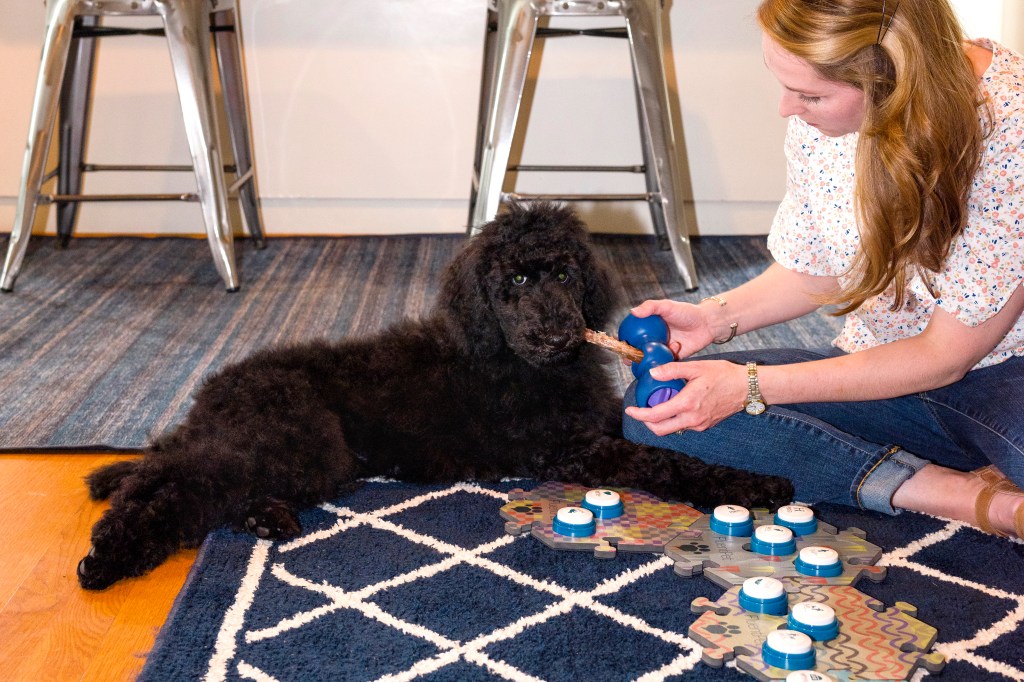Canine communication devices have been around for decades (check out this one from 1997), but in the last few years, updated versions of the tech have gained popularity. Videos of pups pressing colorful tiles or buttons to ask for a “walk” or “treat” — and sometimes even seeming to string together words into the semblance of a sentence — garner millions of views on social media.
But do these “button dogs,” as they’re referred to, actually understand the recordings that come out of the soundboards when they press their paws down, or are they merely responding to body language cues from their owner?
A new study out of the University of California, San Diego says it’s the former — to some degree, at least. The research, published Aug. 28, found that dog participants were able to successfully associate words their owners had recorded onto soundboards with the correct outcomes in real life, and respond to those words without any other cues.
“This study addresses public skepticism about whether dogs truly understand what the buttons mean,” study lead Federico Rossano, a cognitive scientist recently featured in the Netflix documentary Inside the Mind of a Dog, said in a news release. “Our findings are important because they show that words matter to dogs, and that they respond to the words themselves, not just to associated cues.”
The study was broken into two experiments. First, researchers visited the homes of 30 dogs across the country to test their responses to soundboard buttons. Rather than have the dog press the buttons, the experimenters pressed them while the dog’s owner was out of the room, and then observed the dog’s reaction for 60 seconds.
For the second experiment, the team relied on 29 citizen scientists-slash-dog owners who conducted the trials themselves under remote guidance. They’d either speak the word or push the button and then observe their pup’s response.
Though soundboards have ample room for dozens of words, only three types were evaluated in the research — those indicating mealtime (“eat,” “food,” “dinner,” or “hungry”); going outside (“out” or “outside”); and playing (“play” or “toy”). They also tested a meaningless control word.
The scientists found that dogs were seven times more likely to respond with activity-related behavior to the play and going outside words, regardless of whether the owner or an experimenter said them. The animals did not respond with activity-related behavior to the food words, which could mean they either weren’t hungry or didn’t expect to be fed outside of their usual schedule, the authors wrote.
Prior research has found that dogs can understand words — indeed, most dog owners will confidently share that as fact — but this paper specifically sought to specifically address skepticism surrounding soundboards.
“The skepticism comes mainly for two different reasons: one, the history of animal language studies with nonhuman primates, which was not always ethically conducted and was often anecdotal in nature; and two, the fact that these had become a social media sensation, and anything popular on social media is often frowned upon in scientific environments,” Rossano explained to Newsweek.
“This is a comprehension study, and we have only barely scratched the surface of the type of vocabulary that participants are teaching these dogs,” he added, sharing that the team hopes to evaluate more abstract concepts in its future work.
“Some of our dog participants are currently using more than 100 buttons, often combining them in nonrandom sequences,” he said. “We want to show whether it is possible that these animals can use these buttons reliably, whether they understand the humans when the humans press them, and ultimately whether using these buttons is good for the animals.”
A few experts not involved with the study have stated that it shouldn’t be looked at as groundbreaking, as it only confirms what was already known.
“Dogs act similarly when the button says ‘play’ or ‘out’ as when their person says ‘play’ or ‘out,’ but it’s the owner’s voice on the button, so that is expected,” Alexandra Horowitz, head of the Dog Cognition Lab at Barnard College, told The Washington Post. “Dogs easily learn that my asking, ‘Where’s your ball?’ or a visiting friend asking, ‘Where’s your ball?” and my voice on speakerphone asking, ‘Where’s your ball?’ mean the same thing.”
Still, others in the field are impressed and excited by the findings.
“They really needed to show this,” the University of Zürich’s Mélissa Berthet commented to The Guardian of the study. “And now I think the community of scientists is waiting for the rest that’s going to be exciting.”
RELATED: Research Shows That Dogs Definitely Smile — Learn Why











